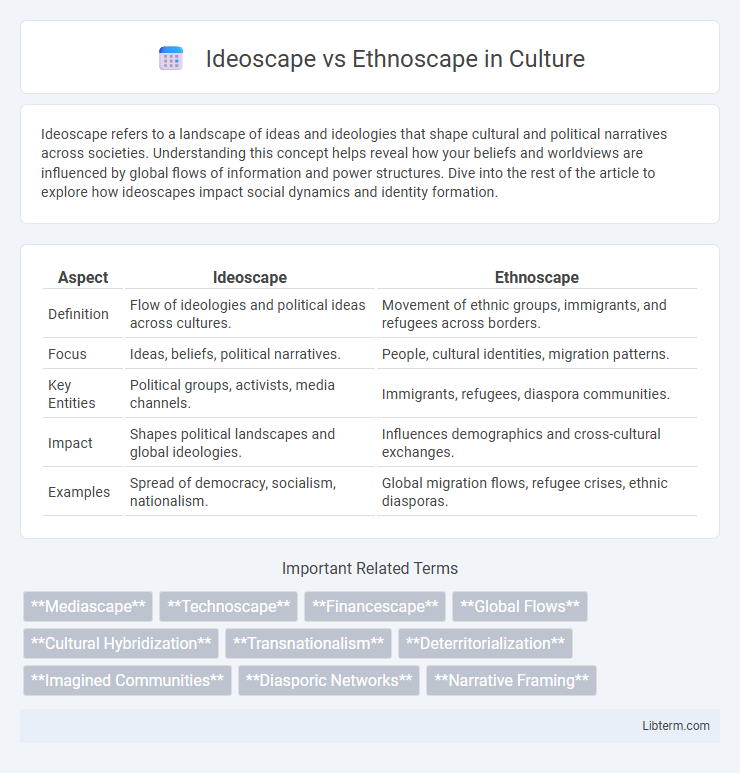Ideoscape refers to a landscape of ideas and ideologies that shape cultural and political narratives across societies. Understanding this concept helps reveal how your beliefs and worldviews are influenced by global flows of information and power structures. Dive into the rest of the article to explore how ideoscapes impact social dynamics and identity formation.
Table of Comparison
| Aspect | Ideoscape | Ethnoscape |
|---|---|---|
| Definition | Flow of ideologies and political ideas across cultures. | Movement of ethnic groups, immigrants, and refugees across borders. |
| Focus | Ideas, beliefs, political narratives. | People, cultural identities, migration patterns. |
| Key Entities | Political groups, activists, media channels. | Immigrants, refugees, diaspora communities. |
| Impact | Shapes political landscapes and global ideologies. | Influences demographics and cross-cultural exchanges. |
| Examples | Spread of democracy, socialism, nationalism. | Global migration flows, refugee crises, ethnic diasporas. |
Introduction to Ideoscape and Ethnoscape
Ideoscape refers to the flow of ideological images, symbols, and narratives that shape political and cultural perceptions across borders, influencing global consciousness and social movements. Ethnoscape describes the dynamic movement of people--such as migrants, refugees, and tourists--who contribute to the transnational flow of cultural identities and demographics. Both concepts highlight the interconnectedness of global landscapes, where Ideoscapes emphasize ideas and Ethnoscapes emphasize human mobility.
Defining Ideoscape: Concepts and Characteristics
Ideoscape refers to the flow of ideas, beliefs, and ideologies that shape political and cultural narratives across global spaces, emphasizing the transmission of values and norms. It involves the circulation of concepts such as democracy, freedom, and nationalism through media, political discourse, and transnational networks. Ideoscape's characteristics include fluidity, hybridity, and the capacity to influence collective identities and social movements within interconnected global contexts.
Understanding Ethnoscape: Meaning and Scope
Ethnoscape refers to the landscape of people who constitute the shifting global flow of individuals, including migrants, refugees, tourists, and diaspora communities. Understanding ethnoscape involves analyzing how these population movements reshape social, cultural, and political environments across borders. The scope of ethnoscape encompasses the dynamic interactions among diverse ethnic groups and their impact on identity, belonging, and transnational networks in a globalized world.
Key Differences: Ideoscape vs Ethnoscape
Ideoscape refers to the flow of ideas, ideologies, and political narratives shaping global consciousness, while Ethnoscape centers on the movement and migration of people, including immigrants, refugees, and tourists across borders. Ideoscape influences perceptions and cultural beliefs through media and communication channels, whereas Ethnoscape reflects tangible human mobility and demographic shifts impacting social and cultural landscapes. The key difference lies in Ideoscape's emphasis on abstract ideological dissemination compared to Ethnoscape's focus on physical population flows.
Historical Development and Theoretical Origins
Ideoscape and ethnoscape concepts originate from Arjun Appadurai's theory of global cultural flows, emphasizing distinct dimensions of globalization. Ethnoscapes describe the fluid movement of people across borders shaped by migration, refugees, and tourism since the late 20th century. Ideoscapes trace the spread of political ideologies, images, and narratives evolving historically through colonialism, nationalism, and digital media, shaping collective identities and power structures.
Globalization and the Dynamics of Cultural Flows
Ideoscape represents the global circulation of ideologies, political ideas, and cultural narratives that shape perceptions and influence social movements across borders. Ethnoscape refers to the shifting landscapes of people, including migrants, refugees, and diasporic communities, whose movements transform cultural identities and socioeconomic relations worldwide. Both concepts illustrate how globalization accelerates the complex dynamics of cultural flows, blending political ideologies and human mobility in shaping transnational identities and power structures.
Real-World Examples of Ideoscapes
Ideoscapes represent the flow of ideas and ideologies across cultures, such as the global spread of democracy movements during the Arab Spring, where social media platforms facilitated the rapid exchange of revolutionary concepts. In contrast, ethnoscapes refer to the movement of people, exemplified by migration patterns of refugees from Syria to Europe. The ideological transmission seen in ideoscapes shapes political frameworks and cultural norms worldwide, influencing international policies and activist networks.
Ethnoscape in Migration and Diaspora Studies
Ethnoscape refers to the dynamic landscape of migrating individuals, encompassing immigrants, refugees, expatriates, and diasporic communities shaping global demographics. In Migration and Diaspora Studies, Ethnoscape highlights how human mobility transforms social, cultural, and political boundaries, influencing identity formation and transnational connections. This concept contrasts with Ideoscape, which centers on the circulation of ideologies and political ideas, focusing more on belief systems than on population movements.
Interactions Between Ideoscape and Ethnoscape
Interactions between ideoscape and ethnoscape shape global cultural dynamics by influencing how ideas and identities spread across borders. Ethnoscape, representing the movement of people such as migrants, refugees, and tourists, facilitates the transmission and reinterpretation of ideologies embedded in the ideoscape, which includes political narratives, values, and belief systems. This interplay drives social transformations and affects political discourse by merging diverse cultural perspectives with dominant ideological frameworks.
Implications for Identity and Cultural Change
Ideoscape represents the flow of ideologies and political ideas shaping individual and collective identity, driving cultural change through the diffusion of values and beliefs across borders. Ethnoscape refers to the migration and movement of people, influencing identity formation by integrating diverse ethnic backgrounds and fostering multicultural dynamics. The interaction between ideoscapes and ethnoscapes catalyzes identity negotiation, where cultural practices are continuously redefined by both ideological shifts and demographic transformations.
Ideoscape Infographic

 libterm.com
libterm.com